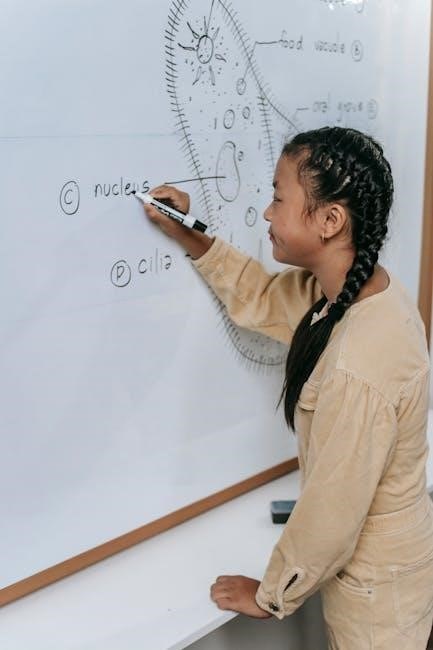Biology is the scientific study of life‚ exploring its properties‚ processes‚ and diversity․ It examines organisms from molecules to ecosystems‚ providing insights into life’s complexity and interconnectedness․
1․1 Key Concepts and Branches of Biology
Biology encompasses various branches‚ including botany‚ zoology‚ ecology‚ genetics‚ and biochemistry․ Key concepts include homeostasis‚ metabolism‚ reproduction‚ and heredity․ These branches explore life at different levels‚ from molecular biology to entire ecosystems‚ providing a comprehensive understanding of living organisms and their interactions with the environment․
1․2 Importance of Studying Biology
Studying biology is essential for understanding life’s fundamental processes and addressing global challenges․ It provides insights into healthcare‚ environmental conservation‚ and agriculture․ Biology equips students with critical thinking skills‚ preparing them for careers in medicine‚ research‚ and sustainability․ By studying biology‚ individuals gain a deeper appreciation of life’s complexity and their role in preserving it for future generations․

Cell Structure and Function
Cells are the basic units of life‚ functioning as self-contained systems․ They consist of a nucleus‚ cytoplasm‚ and membranes‚ enabling processes like growth‚ reproduction‚ and energy production․
2․1 Prokaryotic and Eukaryotic Cells
Prokaryotic cells lack a nucleus and membrane-bound organelles‚ while eukaryotic cells have a nucleus and complex organelles․ Prokaryotes are simpler and smaller‚ typically bacteria‚ whereas eukaryotes include plants‚ animals‚ and fungi․ Key differences include cell size‚ complexity‚ and the presence of a nucleus and organelles‚ influencing their functions and metabolic capabilities․ Understanding these distinctions is crucial for studying cellular biology and evolution․
2․2 Cell Membrane and Transport
The cell membrane is a semi-permeable phospholipid bilayer regulating the movement of substances in and out of the cell․ Passive transport includes diffusion‚ osmosis‚ and facilitated diffusion‚ requiring no energy․ Active transport involves energy and pumps‚ like the sodium-potassium pump‚ to move substances against concentration gradients․ Endocytosis and exocytosis are mechanisms for transporting large molecules or particles․ Understanding membrane structure and transport is essential for cellular function and homeostasis in organisms․
2․3 Cell Organelles and Their Functions
Key organelles include the nucleus‚ mitochondria‚ ribosomes‚ endoplasmic reticulum‚ and Golgi apparatus․ The nucleus houses DNA‚ controlling cell activities․ Mitochondria generate energy via ATP production․ Ribosomes synthesize proteins‚ while the endoplasmic reticulum processes proteins and lipids․ The Golgi apparatus modifies‚ packages‚ and distributes these molecules․ Lysosomes contain digestive enzymes‚ and the cytoskeleton maintains cell shape and aids in movement․ Each organelle has specialized roles vital for cellular survival and function․

Biological Molecules
Biological molecules include carbohydrates‚ lipids‚ proteins‚ and nucleic acids․ They serve as energy sources‚ structural components‚ and genetic material‚ essential for life and cellular functions․

3․1 Carbohydrates‚ Lipids‚ Proteins‚ and Nucleic Acids
Carbohydrates are primary energy sources‚ such as glucose and starch․ Lipids‚ including fats and oils‚ store energy and form cell membranes․ Proteins‚ built from amino acids‚ perform diverse functions․ Nucleic acids‚ like DNA and RNA‚ store and transmit genetic information․ Understanding these molecules is crucial for studying metabolism‚ genetics‚ and cellular processes․
3․2 Metabolism and Energy Production
Metabolism encompasses the chemical reactions converting energy and synthesizing molecules․ Cellular respiration‚ including glycolysis‚ Krebs cycle‚ and oxidative phosphorylation‚ generates ATP‚ the energy currency․ Photosynthesis in plants produces glucose and oxygen․ Enzymes catalyze these reactions‚ ensuring efficiency․ Energy production is vital for maintaining life processes‚ from growth to reproduction‚ highlighting the central role of metabolism in sustaining cellular and organismal functions․

Genetics and Heredity
Genetics studies how traits are inherited and expressed․ DNA carries genetic information‚ and genes determine characteristics․ Mutation and Mendelian laws explain heredity patterns․
4․1 Mendelian Laws of Inheritance
Mendelian laws form the basis of genetic inheritance‚ describing how traits pass from parents to offspring․ The Law of Segregation states alleles separate during gamete formation․ The Law of Independent Assortment explains random separation of non-homologous chromosomes․ The Law of Dominance clarifies phenotypic outcomes based on dominant and recessive alleles․ These principles help predict trait inheritance patterns‚ essential for understanding genetic diversity and heredity․
4․2 DNA Structure and Replication
DNA’s double-helix structure consists of sugar-phosphate backbones and nitrogenous base pairs (A-T‚ C-G)․ Replication is semi-conservative‚ with each strand serving as a template․ Helicase unwinds DNA‚ primers initiate synthesis‚ and DNA polymerase extends chains․ Okazaki fragments form on the lagging strand‚ ensuring continuity․ This precise process maintains genetic information‚ vital for heredity and cellular function․
4․3 Gene Expression and Mutation
Gene expression involves transcription of DNA into mRNA and translation into proteins․ RNA polymerase initiates transcription‚ while ribosomes synthesize proteins․ Mutations‚ or DNA sequence changes‚ can alter gene expression․ Types include point mutations (substitutions)‚ insertions‚ or deletions․ Mutations may be neutral‚ beneficial‚ or harmful‚ influencing evolution․ Natural selection determines their persistence in populations․ Understanding gene expression and mutations is crucial for studying genetic disorders and evolutionary changes․

Evolution and Natural Selection
Evolution is the change in species’ traits over generations․ Natural selection drives this process through genetic variation and environmental pressures‚ favoring adaptive traits that enhance survival and reproduction․
5․1 Evidence for Evolution
The evidence for evolution includes fossil records showing transitional species‚ comparative anatomy revealing homologous structures‚ and molecular biology demonstrating genetic similarities․ Biogeography explains species distribution patterns‚ while natural selection observes evolutionary changes․ These diverse lines of evidence collectively support the theory of evolution‚ illustrating how species adapt and diversify over time․ Understanding these concepts is crucial for grasping the mechanisms driving life’s complexity and biodiversity on Earth․
5․2 Mechanisms of Natural Selection
Natural selection drives evolutionary change by favoring traits that enhance survival and reproduction․ It operates through variation in populations‚ heritable traits‚ and environmental pressures․ Organisms with advantageous traits are more likely to survive and pass those traits to offspring․ Over time‚ this leads to adaptation‚ as populations become better suited to their environments․ This mechanism is a key driver of biodiversity and ecological balance‚ shaping species over generations through differential reproductive success․
5․3 Speciation and Phylogeny
Speciation is the process by which new species emerge‚ often due to geographic isolation or reproductive barriers․ Phylogeny studies the evolutionary relationships among organisms‚ constructing trees that reflect shared ancestry․ Both concepts explain biodiversity and how species diverge over time․ Understanding these mechanisms helps trace life’s history and predict future evolutionary changes‚ essential for grasping the complexity of life on Earth and its dynamic nature․

Ecology and Ecosystems
Ecology studies interactions between organisms and their environment‚ focusing on energy flow‚ nutrient cycles‚ and community dynamics․ Ecosystems are complex networks shaping life’s sustainability and biodiversity․
6․1 Energy Flow and Nutrient Cycles
Energy flows through ecosystems via food chains and webs‚ starting with producers like plants using photosynthesis․ Consumers obtain energy by eating other organisms‚ while decomposers recycle nutrients․ Nutrient cycles‚ such as carbon‚ nitrogen‚ and phosphorus‚ ensure elements are reused․ Energy is lost at each trophic level‚ following the law of conservation of energy․ These processes sustain life and maintain ecosystem balance‚ highlighting the interconnectedness of biotic and abiotic components in nature․
6․2 Interactions in Ecosystems
Interactions in ecosystems involve relationships between organisms and their environment․ These include predation‚ competition‚ mutualism‚ and commensalism․ Predator-prey dynamics regulate populations‚ while symbiotic relationships enhance survival․ Competition for resources drives adaptation‚ shaping species’ roles․ These interactions maintain ecosystem balance‚ ensuring stability and biodiversity․ Understanding these relationships is crucial for grasping how ecosystems function and respond to changes‚ emphasizing the interconnectedness of biotic and abiotic components․
6․3 Human Impact on the Environment
Human activities significantly alter ecosystems‚ causing deforestation‚ pollution‚ and climate change․ Overexploitation of resources and habitat destruction threaten biodiversity․ Pollution disrupts nutrient cycles and harms wildlife‚ while greenhouse gases drive global warming․ Human population growth and consumption patterns exacerbate these impacts․ Understanding these effects is crucial for developing sustainable practices to mitigate environmental damage and preserve ecosystems for future generations․

Scientific Methods and Lab Techniques
The scientific method involves observation‚ hypothesis‚ experimentation‚ and conclusion․ Lab techniques include microscopy‚ dissection‚ and measurement tools․ These skills are essential for accurate biological investigations and analysis․
7․1 The Scientific Method
The scientific method is a systematic process for exploring questions about the natural world․ It begins with observations‚ leading to the formulation of a hypothesis․ Controlled experiments are designed to test the hypothesis‚ and data is collected to analyze and draw conclusions․ Repeatability and peer review ensure the validity and reliability of the findings․ This method is fundamental in biology for conducting rigorous and unbiased research․
7․2 Lab Equipment and Microscopy
Lab equipment and microscopy are essential tools in biology․ Microscopes‚ such as light and electron microscopes‚ allow detailed observation of cells and tissues․ Other key tools include Bunsen burners‚ test tubes‚ and pipettes for handling materials․ Glassware like beakers and flasks are used for mixing and storing solutions․ Proper use and maintenance of equipment ensure accurate and safe experimentation‚ fostering a deeper understanding of biological processes and structures․
7․3 Experimental Design and Variables
Experimental design in biology involves planning and executing studies to test hypotheses․ It includes identifying independent variables (manipulated)‚ dependent variables (measured)‚ and controlled variables (kept constant)․ A well-designed experiment ensures validity and reliability․ Control groups and experimental groups are used for comparison․ Randomization and replication minimize bias․ Data collection and analysis help draw conclusions․ Understanding variables and experimental design is crucial for conducting scientific investigations and interpreting results accurately in biological studies․

Study Tips and Exam Strategies
Use active learning methods‚ flashcards‚ and practice past papers; Focus on understanding concepts rather than memorizing․ Manage time effectively during exams and stay confident․ Prioritize key topics․
8․1 Effective Study Habits for Biology
Develop a structured study plan‚ focusing on key concepts and topics․ Use flashcards for memorizing terms and processes․ Engage with diagrams and visuals to understand complex structures․ Regularly review notes and textbook chapters․ Practice past exam questions to identify weak areas․ Teach concepts to others to reinforce understanding․ Stay organized and maintain a consistent study routine to build confidence and mastery․
8․2 Practicing with Past Exam Questions
Practicing with past exam questions helps identify weak areas and improves problem-solving skills․ Use flashcards to memorize key terms and processes․ Review mistakes to understand common pitfalls․ Simulate exam conditions to build time management skills․ Focus on understanding concepts rather than just memorizing facts․ Regular practice with past papers boosts confidence and familiarity with exam formats‚ ensuring better performance on the final exam․
8․3 Time Management During the Exam
Effective time management is crucial for success in biology exams․ Allocate time to each section based on the number of questions and their difficulty․ Skim through the entire paper first to identify easy and challenging questions․ Budget time for each question‚ ensuring you leave some for review․ Avoid spending too long on a single question‚ as this can jeopardize your ability to answer others․
Use a systematic approach to tackle questions‚ starting with those you find easiest․ For multiple-choice questions‚ eliminate incorrect options to increase your chances of selecting the right answer․ Manage your time wisely to complete all sections‚ ensuring you have enough minutes left to address complex questions without rushing․ Staying calm and organized will help you maximize your score․